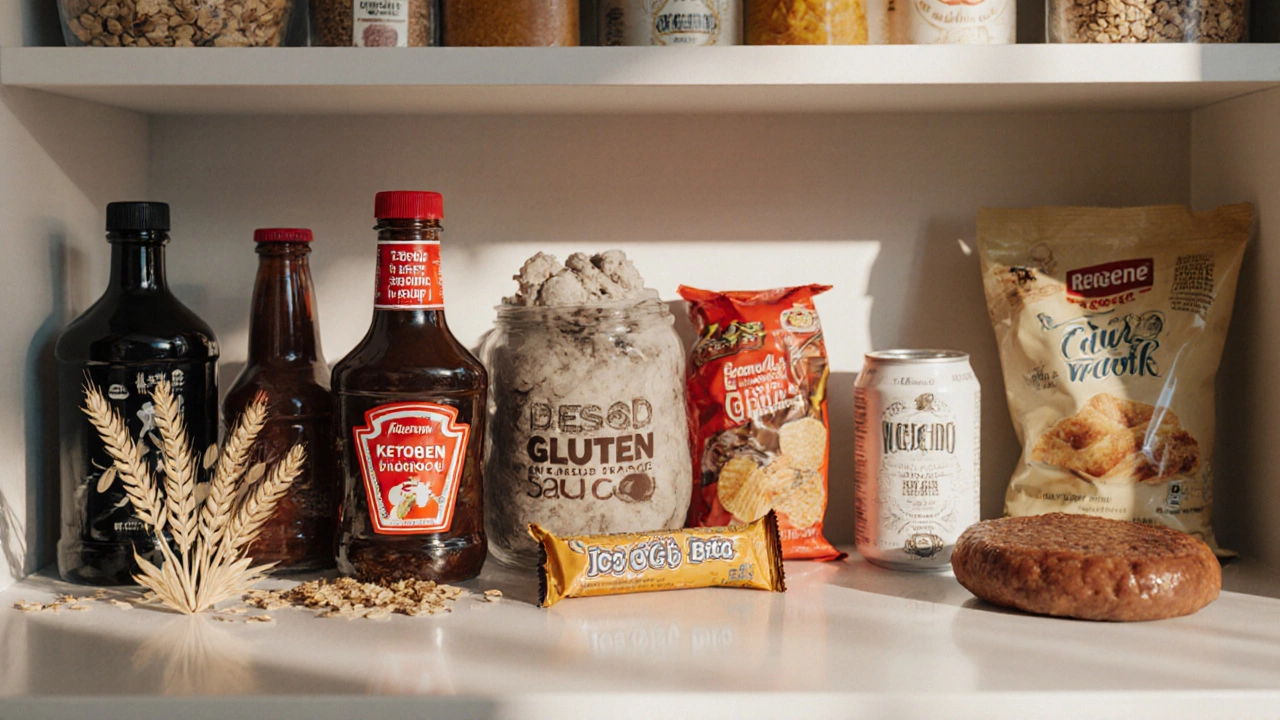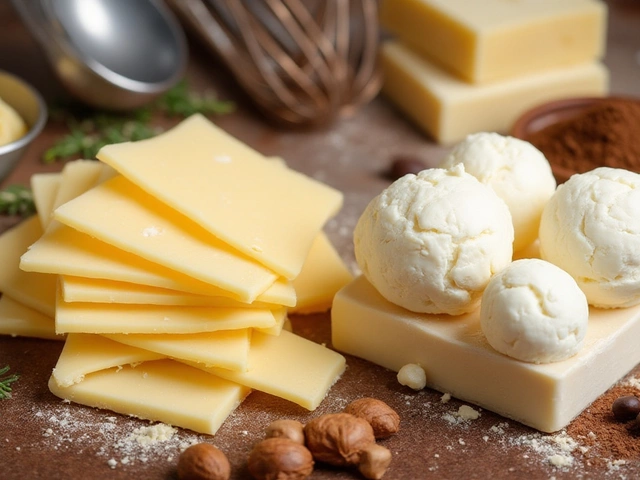
Hidden Gluten Ingredient Checker
Common Hidden Gluten Sources
Soy Sauce
Traditional soy sauce contains wheat. Look for tamari or coconut-amino.
Contains GlutenMalt
Derived from barley or wheat, used in beverages and snacks.
Contains GlutenHydrolyzed Wheat Protein
Used as a flavor enhancer in sauces and processed foods.
Contains GlutenModified Food Starch
Often wheat-derived unless specifically labeled otherwise.
May Contain GlutenOats
Naturally gluten-free but often cross-contaminated during processing.
Cross-Contamination RiskTaco Seasoning
Often includes wheat flour as an anti-caking agent.
Contains GlutenWhen you’re on a strict gluten‑free regimen, you quickly learn that gluten isn’t limited to a loaf of bread or a slice of pizza. It slips into a surprising range of foods, turning a “safe” snack into a hidden hazard. This guide reveals the most common culprits, shows you how to decode labels, and gives practical tips to avoid accidental exposure.
What is gluten and why does it hide?
Gluten is a protein composite found in certain grains that gives dough its elasticity and helps foods retain shape. It’s primarily present in wheat, a staple grain used in flour, pasta, and many processed ingredients, barley and rye. Even grains that are naturally gluten‑free, like oats, often become contaminated during harvest or processing, which is why they carry a “gluten‑free” certification when safe.
Manufacturers add gluten‑containing ingredients for texture, flavor, or as cheap fillers. Because the label may list a derivative name-malt, hydrolyzed wheat protein, or even “flavoring”-the risk is easy to miss unless you know the aliases.
Surprising food categories that can contain gluten
- Sauces, gravies and dressings
- Spices, seasonings and marinades
- Processed snack foods
- Dairy‑based desserts and ice‑cream
- Beverages, including non‑alcoholic drinks
- Meat substitutes and processed meats
Sauces, gravies, and dressings
Many pantry staples use soy sauce, a fermented soy product traditionally brewed with wheat, as a flavor base. Even gluten‑free versions exist, but the regular bottle you grab at the supermarket usually contains wheat. Look for “tamari” or a label that explicitly says “gluten‑free.”
Barbecue sauces, teriyaki sauces, and certain ketchup varieties may contain malt, a sweetener derived from barley, or “hydrolyzed wheat protein” used to enhance umami.
Prepared gravies and canned soups often rely on bouillon cubes or “stock powders” that list wheat starch, barley malt extract, or a “flavoring” that hides gluten.
Spices, seasonings, and marinades
Even pure‑spice blends can be a trap. “Seasoned salt,” “taco seasoning,” and “curry powders” may include wheat flour as an anti‑caking agent. Pre‑mixed spice mixes for BBQ rubs frequently contain maltodextrin sourced from wheat.
Check the ingredient list for “tricalcium phosphate” (a gluten‑free anti‑clump) versus “modified food starch,” which is often derived from wheat unless labeled otherwise.
Processed snack foods
Potato chips sound safe, but many flavored varieties-sour cream and onion, barbecue, ranch-use powdered dairy or spice mixes that include wheat‑derived thickeners. Even “gluten‑free” labeled chips can be at risk if the facility processes wheat on the same line.
Granola bars, energy balls, and protein bars often list “oats” or “brown rice syrup” alongside “wheat germ” or “malt extract.” The infamous “chewy” texture in many snack bars comes from wheat‑based gelatin or wheat starch.
Dairy‑based desserts and ice‑cream
Ice‑cream manufacturers sometimes add “stabilizers” like carrageenan blended with wheat starch to improve texture. Certain “flavored” yogurts and puddings contain malted milk powder-another barley derivative.
Even classic desserts such as “tiramisu” or “cheesecake” recipes that call for “flour” in the crust or “sponge” layer can sneak gluten into a seemingly gluten‑free treat.
Beverages
Beer is the obvious one-made from barley, sometimes blended with wheat or rye. But gluten can also appear in “gluten‑free” labeled craft beers if they use malted barley in the mash.
Non‑alcoholic drinks like malted milkshakes, certain flavored coffees, and “energy drinks” may use maltodextrin for sweetness, which often originates from wheat.
Meat substitutes and processed meats
Vegetarian “sausage,” “burger,” or “chicken” patties frequently use wheat gluten (also called seitan) as a protein binder. Even some “plant‑based” deli slices rely on wheat‑based textures.
Traditional deli meats, hot dogs, and “ready‑to‑heat” meals sometimes contain “dextrose” or “hydrolyzed soy protein,” which can be derived from wheat unless specified.
How to read labels like a pro
- Scan the first 5 ingredients - if wheat, barley, rye, oats, or malt appear, the product is not safe.
- Watch for “derived from” statements - “flavoring derived from wheat,” “malt‑flavored,” “hydrolyzed wheat protein.”
- Look for certified gluten‑free symbols - a trusted third‑party logo (e.g., Coeliac UK).
- Check the “may contain” disclaimer - cross‑contamination risk is high if the manufacturer processes gluten‑containing foods on the same line.
- Use smartphone apps that scan barcodes and cross‑reference with gluten‑free databases.

Cross‑contamination: Kitchen safety tips
- Designate separate cutting boards, knives, and toasters for gluten‑free meals.
- Rinse any shared pots or pans thoroughly before using them for gluten‑free cooking.
- Store gluten‑free items on a higher shelf to avoid accidental spills from gluten‑containing products.
- Teach family members the importance of checking labels even for “home‑cooked” sauces.
Quick reference checklist
| Category | Typical gluten source | Gluten‑free alternative |
|---|---|---|
| Sauce | Regular soy sauce | Tamari or coconut‑amino |
| Seasoning | Seasoned salt | Pure sea salt + herbs |
| Snack | Flavored chips | Plain potato chips or certified gluten‑free corn chips |
| Dessert | Malted milk powder | Gluten‑free vanilla bean or dairy‑only |
| Beverage | Beer (barley) | Gluten‑free brewed beer or cider |
| Meat substitute | Seitan‑based patty | Pea‑protein or lentil burger |
Why hidden gluten foods matter for celiac health
Consuming even tiny amounts of gluten can trigger an immune response in people with celiac disease, damaging the small intestine and leading to symptoms ranging from abdominal pain to nutrient deficiencies. Because the latency period can be delayed, you might not connect a flare‑up with a “safe” snack-until you spot the hidden source.
Next steps: Building a gluten‑aware pantry
Start by stocking the basics: certified gluten‑free flours (rice, almond, buckwheat), gluten‑free oats, and trusted sauces. Keep a small notebook on your fridge where you jot down any new ingredients you discover that contain gluten. Over time, you’ll develop a mental checklist that prevents accidental ingestion.
Remember, staying safe isn’t about fearing every ingredient; it’s about knowledge and vigilance. Once you master the hidden sources, you can enjoy a broader variety of foods without compromising your health.
Frequently Asked Questions
Can oats be safe on a gluten‑free diet?
Only if they’re labeled “certified gluten‑free.” Regular oats are often processed in facilities that also handle wheat, leading to cross‑contamination.
Is soy sauce always off‑limits?
Traditional soy sauce contains wheat, but you can use tamari or coconut‑amino, which are gluten‑free and provide a similar salty‑umami flavor.
Do gluten‑free labels guarantee safety?
A certified gluten‑free label means the product contains less than 20ppm gluten, but it doesn’t always protect against cross‑contamination in shared facilities. Look for a “produced in a dedicated gluten‑free facility” note if you’re highly sensitive.
How can I eat out without risk?
Call ahead, ask for a gluten‑free menu, and request that staff use separate utensils and cooking surfaces. Choose dishes based on whole, naturally gluten‑free foods like grilled fish, salads without croutons, and rice‑based sides.
What’s the best way to test a new product?
Read the ingredient list and allergen statement thoroughly. If you’re uncertain, contact the manufacturer’s customer service for clarification before trying it.





